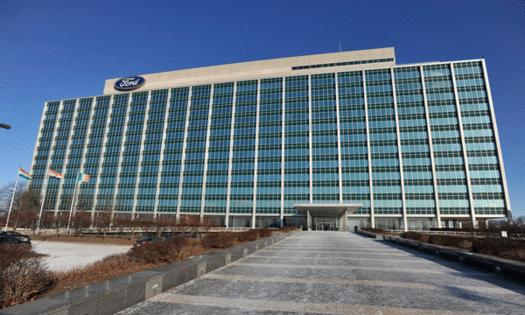Ford issues tariff-hit guidance after reporting Q2 loss from special charges
Published in Automotive News
Ford Motor Co. on Wednesday declared a net loss of $36 million in the second quarter of 2025 related to one-time charges and issued a lower annual guidance for adjusted operating profit as it projects higher tariff costs.
The Dearborn automaker now expects the import taxes will affect adjusted operating profit by $2 billion this year, up from the $1.5 billion it forecasted in May. Its new guidance puts its annual operating income at $6.5 billion to $7.5 billion, down from the forecast it suspended this spring of $7 billion to $8.5 billion and lower than 2024's $10.2 billion results.
"We've shared those numbers with the administration," Chief Financial Officer Sherry House said during an earnings briefing call. "They've made it clear to us that Ford is the most American automaker, and it should not be disadvantaged in the long run, and in fact, we're having very constructive conversations with them to ensure a more level playing field. So, we are optimistic at this point, but we do have real work to do."
Although there was a $800 million net effect of tariffs on the company's $2.1 billion adjusted operating income, Ford attributed the net loss primarily to special charges related to a recall and expenses from the cancelation of a three-row all-electric SUV that was expected to be unprofitable for too long. In August, the company said it would write off as much as $1.9 billion for the cut program.
The results are a picture into how the Blue Oval is faring in the new trade environment. Although Ford builds more vehicles in the United States than any other automaker and 80% of the vehicles it sells here are assembled here, it faces duties on parts to build its popular F-Series trucks and SUVs, and has a cost structure it seeks to address to better compete with rivals. But the challenges are expected to worsen with a Friday deadline approaching when certain import taxes increase, and President Donald Trump has threatened to raise tariffs on Canada and Mexico.
"For us, parts is a big issue," House said. "We are optimistic that we'll be able to get some improvements here that will accrete to our bottom line."
The results also are another sign of Ford's quality problems weighing on its financial results. The Blue Oval has issued more recalls so far this year than any automaker has in a full year. The company, however, insists the vehicles it's producing today are showing among its best quality results and the larger number of recalls means it's catching problems sooner under revamped procedures.
Earlier this month, Ford issued a recall on 700,000 vehicles of certain 2020-24 Bronco Sport and Escape SUVs over fires resulting from a cracked fuel injector. The company disclosed in a regulatory filing that it expects to incur $570 million in costs to find a fix for the problem. Field service action for that issue represented half of the special charges for the second quarter that resulted in the loss, House said.
"Where we've seen some of the issues cropping up," she said, "has been on vehicles that were produced many years ago, designed many years ago, and we are working through that systematically."
Warranty costs, she added, are down year-over-year. Cost improvements also are down or a fourth consecutive quarter. The company still is aiming for a $1 billion cost reduction there without factoring in the costs of tariffs.
In the April-through-June quarter, Ford's adjusted operating income margin was 4.3% on record revenue of $50.2 billion, which was up 5% from a year ago. Although operating profit fell a quarter, and margin was down from 5.8%, Ford's results surpassed average analyst predictions, according to Yahoo Finance.
On average, analysts were expecting revenue of $43.93 billion and earnings of 33 cents per share. Ford recorded adjusted earnings per share of 37 cents for the quarter.
Because of tariff uncertainty, Ford in May suspended its guidance for an adjusted operating profit of $7 billion to $8.5 billion that it provided in February, despite tracking within that forecast. The net effect of tariffs in the first quarter was roughly $200 million. The suspended guidance would've been a 17% to 31% decrease from 2024. Now, Ford is predicting a 26% to 36% decline.
It expects gross impact of tariffs to be $3 billion, up from the previously forecasted $2.5 billion. It expects $1 billion in offsets from changes in volumes and prices that are being evaluated on a segment and region basis, House said.
"Retail prices are matching up slightly here, and we've already seen about 1% already," House said about price increases in the U.S. market. "That's happening probably a bit slower than we had originally anticipated, as OEMs are using up other inventory that they have before turning to inventory that has the higher tariffs on it, but we expect that these price increases in the retail segment of about 1% will probably hold as we finish out the balance of the year."
Ford offered discounts previously reserved for employees to its customer from early April through the July 4 weekend, contributing to a 6.6% increase in U.S. sales in the first half of the year and a 14% increase in the second quarter. Through Labor Day it is offering zero down payment, zero percent interest for 48 months and zero payments for the first 90 days on most Ford and Lincoln vehicles.
On Friday, higher so-called reciprocal tariffs of at least 15% are slated to take effect on most countries as well as 50% duties on copper. Earlier this month, Trump also threatened to increase import taxes on Canada and Mexico to 35% and 30%, respectively.
But Ford knows it also needs to invest in the future for electrification, connected vehicles and other technologies. It expects $9 billion in capital expenditures, the high end of its previous guidance, and will host an event on Aug. 11 in Kentucky to share more details about its work in designing and building EVs in the United States.
Ford Blue, the company's internal combustion engine and hybrid vehicle business, posted operating income down 43% to $661 million, weighed down by stock buildup of last year's F-150 pickups and tariffs. Its 2.6% operating margin was down from 4.4% a year ago.
Ford Pro, the commercial vehicle business, reported $2.318 billion in operating income, down 9.5% year-over-year, and a 12.3% operating margin compared to 15.1% a year ago. The automaker on Wednesday named Alicia Boler Davis, a former General Motors Co. executive, as the next president to lead the division effective Oct. 1.
The loss posted by Ford Model e, the business unit dedicated to electric vehicles, was $1.329 billion compared to $1.150 billion in the second quarter of 2024.
The losses in the division reflect tariffs, investments in future EVs and costs associated with the new battery plant in south-central Michigan's Marshall. But revenues int he segment doubled to $2.4 billion and flat operating profit on the Mustang Mach-E and F-150 Lightning underscored the company's cost reduction efforts, according to Ford.
The company didn't provide updated guidance for its three divisions. In May, it suspended predictions for operating earnings in Ford Blue of $3.5 billion to $4 billion and in Ford Pro of $9 million. It also had predicted a $5 billion to $5.5 billion loss for Model e.
Adjusted free cash flow was $2.8 billion, and it predicts the measure will range from $3.5 billion to $4.5 billion for 2025, which is unchanged from earlier this year. At the end of the quarter, Ford had $28.4 billion in cash and $46.6 billion in liquidity. Still, Ford on Tuesday took out a $3 billion line of credit it can access over the next year.
"This invaluable financial flexibility gives us the ability to invest through an economic downturn to fund growth in competitive segments and continue our transformation," House said. "We do think the U.S. outlook calls for slower growth, but certainly not a recession."
Ford will pay a 15-cent dividend on Sept. 2 to shareholders of record on Aug. 11. For the full first half of 2025, Ford's net income is $400 million on $90.8 billion in revenue.
Last week, General Motors Co. said it's on track to meet lowered projected earnings of $10 billion to $12.5 billion this year. Net income was $1.9 billion on $47.122 billion revenue for the second quarter. For the first half, GM's net profit is $4.68 billion on $91.141 billion in revenue.
Chrysler parent Stellantis NV on Tuesday reported first-half results of $2.61 billion on $85.907 billion in revenue and reinstituted its suspended guidance of improved revenue in the first half and a low single-digit adjusted operating income margin.
©2025 www.detroitnews.com. Visit at detroitnews.com. Distributed by Tribune Content Agency, LLC.








Comments